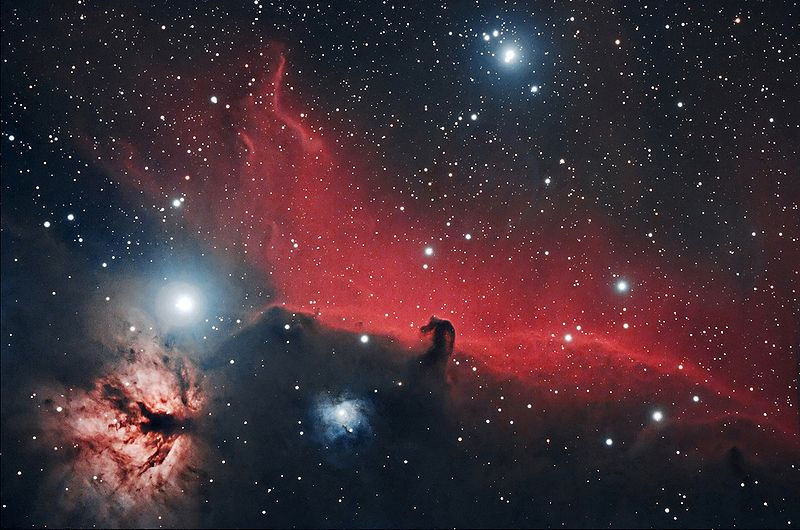§ Nebula — Latin: "mist"; pl. nebulae
1. From the Online Etymology Dictionary: astronomical meaning "cloud-like patch in the night sky" first recorded c.1730. As early as Herschel (1802) astronomers realized that some nebulae were star clusters, but distinction of gas clouds from distant galaxies was not made until c.1930.
§ Contents
- You Should Know — Nebula Terminology
In This Section You Should Know — Definitions from the Astronomical Science of Nebulae - The Cradle of Star Formation
Emission Nebula — The Birthplace of Stars - The Nebulae
Reflections on a Nebula — From the Pleiades to IC 2118 - Planetary Nebula
From a Universe of Beauty — Stars that Shape Forms - Remnants of a Massive Explosion
Supernova Remnants — Titanic Forces Shape a Nebula - Dark or Absorption Nebulae
Seeing In the Dark — Backdrops of Illumination - Imaging the Nebula Under Edit
The Protoplanetary Nebulae — Amazing Images of Nebulae - Subsequent chapters under construction
- Bibliography
Origins
"There are two different origins of nebulae. The first origin for material is the universe's creation itself: Soon after its birth, atoms were created in the universe, and it is from these that the first dust and gas clouds formed. This means that the gas and dust that make up this type of nebula were not created in a star, but are the original matter from the beginnings of the universe. The second kind of nebulae are produced by the supernovas of exploding stars. The matter ejected from them created the Veil and Crab nebulae, as well as many more. Also, keep in mind that the origins of nebulae are not as clear cut as this; a nebula can be a mixture of primordial material as well as new material from previous stars."
Journey through the Galaxy — Stuart Robbins & David McDonald
5. Remnants of a Massive Explosion
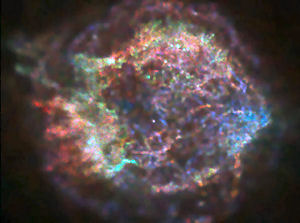 It is the most awesome force known in nature, it's massive explosion so great that it outshines entire galaxies, the event seen clear across an entire universe billions of light years away! The heat of it's shock wave is powerful enough to roll through our entire solar system, consuming everything in it's path without even slowing down — this is the Supernova. It's force "expels much or all of a star's material at a velocity of up to a tenth the speed of light (30,000 km/s), driving a shock wave into the surrounding interstellar medium." It is this shock wave, moving away in all directions, sweeping up material in an expanding shell of gas and dust that forms our next type of Nebula, the Supernova Remnant. [13] At left is the Chandra X-ray image of the supernova remnant in the constellation Cassiopeia and known as Cassiopeia A or Cas A. "The red, green, and blue regions in this Chandra X-ray image of the supernovas remnant Cassiopeia A show where the intensity of low, medium, and high-energy X-rays, respectively, is greatest. The red material on the left outer edge is enriched in iron, whereas the bright greenish white region on the lower left is enriched in silicon and sulfur. In the blue region on the right edge, low and medium energy X-rays have been filtered out by a cloud of dust and gas in the remnant." Image and text from the Chandra website. Author note: Image enhanced from the orginal in order to show detail.
It is the most awesome force known in nature, it's massive explosion so great that it outshines entire galaxies, the event seen clear across an entire universe billions of light years away! The heat of it's shock wave is powerful enough to roll through our entire solar system, consuming everything in it's path without even slowing down — this is the Supernova. It's force "expels much or all of a star's material at a velocity of up to a tenth the speed of light (30,000 km/s), driving a shock wave into the surrounding interstellar medium." It is this shock wave, moving away in all directions, sweeping up material in an expanding shell of gas and dust that forms our next type of Nebula, the Supernova Remnant. [13] At left is the Chandra X-ray image of the supernova remnant in the constellation Cassiopeia and known as Cassiopeia A or Cas A. "The red, green, and blue regions in this Chandra X-ray image of the supernovas remnant Cassiopeia A show where the intensity of low, medium, and high-energy X-rays, respectively, is greatest. The red material on the left outer edge is enriched in iron, whereas the bright greenish white region on the lower left is enriched in silicon and sulfur. In the blue region on the right edge, low and medium energy X-rays have been filtered out by a cloud of dust and gas in the remnant." Image and text from the Chandra website. Author note: Image enhanced from the orginal in order to show detail.Describing the type of supernova that created Cas A, the HubbleSite NewsCenter says, "A supernova such as the one that resulted in Cas A is the explosive demise of a massive star that collapses under the weight of its own gravity. The collapsed star then blows its outer layers into space in an explosion that can briefly outshine its entire parent galaxy. Cas A is relatively young, estimated to be only about 340 years old. Hubble has observed it on several occasions to look for changes in the rapidly expanding filaments." What they are describing is a Type II Supernova and "it belongs to a sub-category of cataclysmic variable star known as a core-collapse supernova, which results from the internal collapse and violent explosion of a massive star." [14] For more in-depth study on Type II Supernova, see this site's section entitled "Neutron Star — Formation" or visit the PBS online website at NOVA Online | Runaway Universe | Birth of a Supernova: Type II
The 100 Million Sun-Powered Supernova 1987A
 Twenty-two years ago one of the brightest and most massive stellar explosions in more than 400 years occurred. It was called Supernova SN 1987A and it lit up the firmament with the power of 100 million suns for several months following its discovery on Feb. 23, 1987.
Twenty-two years ago one of the brightest and most massive stellar explosions in more than 400 years occurred. It was called Supernova SN 1987A and it lit up the firmament with the power of 100 million suns for several months following its discovery on Feb. 23, 1987."Observations of SN 1987A, made over the past 20 years by NASA's Hubble Space Telescope and many other major ground- and space-based telescopes, have significantly changed astronomers' views of how massive stars end their lives. Astronomers credit Hubble's sharp vision with yielding important clues about the massive star's demise." As to the glowing "pearl-like" balls seen in the image at right, the supernova's heated shock wave is slamming into a ring of debris that had surrounded the star at the time of it's explosion. "The light show makes the glowing ring look like a pearl necklace. Astronomers think the whole ring will be illuminated in a few years...The glowing ring is expected to become bright enough to illuminate the star's surroundings, which will provide astronomers with new information on how the star ejected material before the explosion." HubbleSite NewsCenter Image credit: NASA, ESA, P. Challis and R. Kirshner (Harvard-Smithsonian Center for Astrophysics).
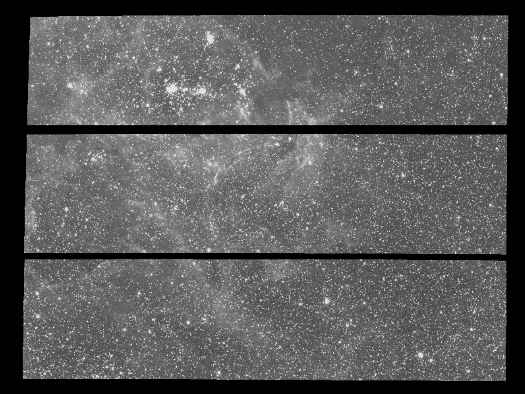 In 2006, the APOD website posted a time-lapsed movie compliation of SN 1987A which the Blanco 4-meter telescope in Chile recorded over four years. Said the APOD editors, "The first image is an image of the SN 1987A region, while the next four images were created by subtracting consecutive images, taken a year apart, and leaving only the difference between the images. Light echoes can be seen moving out from the position of the supernova. The SuperMACHO team who recorded the above light echoes around supernova 1987A has also found faint and previously unnoticed light echoes from two other LMC supernovas. Study of these light echoes has enabled more accurate determinations of the location and date of these two supernova explosions that were first visible hundreds of years ago." [15]
In 2006, the APOD website posted a time-lapsed movie compliation of SN 1987A which the Blanco 4-meter telescope in Chile recorded over four years. Said the APOD editors, "The first image is an image of the SN 1987A region, while the next four images were created by subtracting consecutive images, taken a year apart, and leaving only the difference between the images. Light echoes can be seen moving out from the position of the supernova. The SuperMACHO team who recorded the above light echoes around supernova 1987A has also found faint and previously unnoticed light echoes from two other LMC supernovas. Study of these light echoes has enabled more accurate determinations of the location and date of these two supernova explosions that were first visible hundreds of years ago." [15]Historical Supernovae
SN 1572
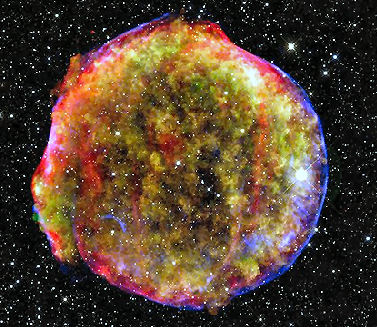 Queen Elizabeth I, Wolfgang Schuler, Thomas Digges, John Dee, Francesco MaurolicoIn and Tycho Brahe all share one thing in common — in November of 1572 they witrnessed a Type Ia Supernova in the constellation Cassiopeia. It appeared in early November 1572 and was visible until March of 1574, having been independently "discovered", in addition to those named above, by many other individuals ( credit for first being observed is given to Wolfgang Schuler from Wittenberg on or about November 6, 1572 ). The name "Tycho's Supernova" was given this object "because of the extensive work De nova et nullius aevi memoria prius visa stella (published in 1573, 1602, and 1610) that contains both Tycho Brahe's own observations and the analysis of those of many other observers." from Wikipedia It was "rediscovered" in the 1960's when an extremely faint nebulosity was identified on photo plates taken with the Mt. Palomar Observatory's telescope. [16] Seen at right is the explosion that "has left a blazing hot cloud of expanding debris (green and yellow) visible in X-rays. The location of ultra-energetic electrons in the blast's outer shock wave can also be seen in X-rays (the circular blue line). Newly synthesized dust in the ejected material and heated pre-existing dust from the area around the supernova radiate at infrared wavelengths of 24 microns (red)" from Chandra X-ray Observatory website. Credit: X-ray: NASA/CXC/SAO, Infrared: NASA/JPL-Caltech; Optical: MPIA, Calar Alto, O.Krause et al.
Queen Elizabeth I, Wolfgang Schuler, Thomas Digges, John Dee, Francesco MaurolicoIn and Tycho Brahe all share one thing in common — in November of 1572 they witrnessed a Type Ia Supernova in the constellation Cassiopeia. It appeared in early November 1572 and was visible until March of 1574, having been independently "discovered", in addition to those named above, by many other individuals ( credit for first being observed is given to Wolfgang Schuler from Wittenberg on or about November 6, 1572 ). The name "Tycho's Supernova" was given this object "because of the extensive work De nova et nullius aevi memoria prius visa stella (published in 1573, 1602, and 1610) that contains both Tycho Brahe's own observations and the analysis of those of many other observers." from Wikipedia It was "rediscovered" in the 1960's when an extremely faint nebulosity was identified on photo plates taken with the Mt. Palomar Observatory's telescope. [16] Seen at right is the explosion that "has left a blazing hot cloud of expanding debris (green and yellow) visible in X-rays. The location of ultra-energetic electrons in the blast's outer shock wave can also be seen in X-rays (the circular blue line). Newly synthesized dust in the ejected material and heated pre-existing dust from the area around the supernova radiate at infrared wavelengths of 24 microns (red)" from Chandra X-ray Observatory website. Credit: X-ray: NASA/CXC/SAO, Infrared: NASA/JPL-Caltech; Optical: MPIA, Calar Alto, O.Krause et al.SN 1604
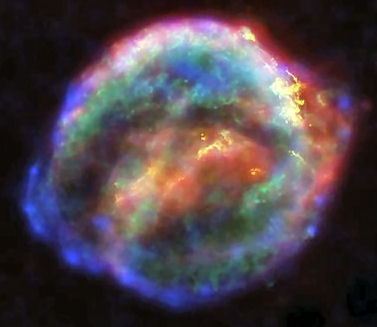 It was the year 1604 and two historical astronmers and mathematicians, the German Johannes Kepler and the Italian Galileo Galilei, had just witnessed the appearence of a bright new object in the sky that was initially brighter than Jupiter. Over the next few weeks the object dimmed, finally fading from view and the two now famous gentlemen labelled it a new star. That was four years before the advent of the telescope and four-hundred years since. Of course, we now know that Kepler's and Galileo's "star" was actually a supernova explosion, today named SN 1604 or Kepler's Supernova Remnant seen in this wonderful 4-color composite image at left . "NASA's three Great Observatories -- the Hubble Space Telescope, the Spitzer Space Telescope, and the Chandra X-ray Observatory -- joined forces to probe the expanding remains of a supernova...The combined image unveils a bubble-shaped shroud of gas and dust that is 14 light years wide and is expanding at 4 million miles per hour (2,000 kilometers per second). Observations from each telescope highlight distinct features of the supernova remnant, a fast-moving shell of iron-rich material from the exploded star, surrounded by an expanding shock wave that is sweeping up interstellar gas and dust." from the Chandra X-ray Observatory website. Chandra x-ray data is seen in Blue and Green, Hubble Space Telescope data seen in Yellow and Spitzer Space Telescope data seen in Red. Credit: NASA/ESA/JHU/R.Sankrit & W.Blair
It was the year 1604 and two historical astronmers and mathematicians, the German Johannes Kepler and the Italian Galileo Galilei, had just witnessed the appearence of a bright new object in the sky that was initially brighter than Jupiter. Over the next few weeks the object dimmed, finally fading from view and the two now famous gentlemen labelled it a new star. That was four years before the advent of the telescope and four-hundred years since. Of course, we now know that Kepler's and Galileo's "star" was actually a supernova explosion, today named SN 1604 or Kepler's Supernova Remnant seen in this wonderful 4-color composite image at left . "NASA's three Great Observatories -- the Hubble Space Telescope, the Spitzer Space Telescope, and the Chandra X-ray Observatory -- joined forces to probe the expanding remains of a supernova...The combined image unveils a bubble-shaped shroud of gas and dust that is 14 light years wide and is expanding at 4 million miles per hour (2,000 kilometers per second). Observations from each telescope highlight distinct features of the supernova remnant, a fast-moving shell of iron-rich material from the exploded star, surrounded by an expanding shock wave that is sweeping up interstellar gas and dust." from the Chandra X-ray Observatory website. Chandra x-ray data is seen in Blue and Green, Hubble Space Telescope data seen in Yellow and Spitzer Space Telescope data seen in Red. Credit: NASA/ESA/JHU/R.Sankrit & W.BlairGotcha! Witnessing a Star's Demise: the Birth of Supernova SN 2008D
 In January of 2008, scientists were doing what scientists do, studying an 88 million light-years distance galaxy named NGC 2770 with the X-ray telescope on NASA's Swift satellite. They were performing a routine observation, looking at another supernova, SN 2007uy when they suddenly found themselves "in the right place at the right time" for a one-in-a-million chance of opportunity.
In January of 2008, scientists were doing what scientists do, studying an 88 million light-years distance galaxy named NGC 2770 with the X-ray telescope on NASA's Swift satellite. They were performing a routine observation, looking at another supernova, SN 2007uy when they suddenly found themselves "in the right place at the right time" for a one-in-a-million chance of opportunity.Theorists had long predicted that a burst of x-rays, from a star gone supernova, would result from the ensuing shock wave as it slammed into the surround interstellar medium. The problem wasn't the technology, it was being able to catch the event as it happened. As was succinctly pointed out by the National Radio Astronomy Observatory, in their article Luck Reveals Stellar Explosion's First Moments, "in order to see this burst, scientists faced the nearly-impossible challenge of knowing in advance where to point their telescopes to catch a supernova in the act of exploding." [17]
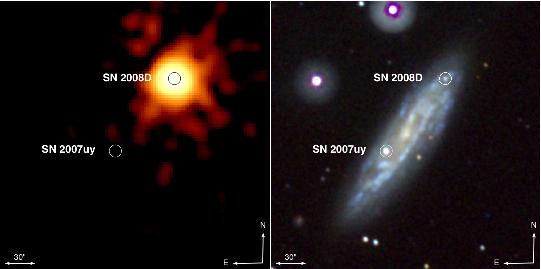 On January 9, 2008 Dr. Alicia Soderberg and her colleagues watched as a large x-ray burst began in one of NGC 2770 sprial arm's. "For years, we have dreamed of seeing a star just as it was exploding," said team leader Alicia Soderberg, a Hubble and Carnegie-Princeton Fellow at Princeton University. "This newly-born supernova is going to be the Rosetta Stone of supernova studies for years to come." Soderberg and 38 international scientists wasted no time in calling in the calvary: Swift's gamma-ray instrument, the Chandra X-ray Observatory, and the Hubble Space Telescope. On the ground, they used the Gemini North telescope and the Keck I telescope in Hawaii, the 200-inch and 60-inch telescopes at Palomar Observatory in California, the 3.5-meter telescope at Apache Point Observatory in New Mexico, and the National Science Foundation's Very Large Array (VLA) and Very Long Baseline Array (VLBA) radio telescopes.
On January 9, 2008 Dr. Alicia Soderberg and her colleagues watched as a large x-ray burst began in one of NGC 2770 sprial arm's. "For years, we have dreamed of seeing a star just as it was exploding," said team leader Alicia Soderberg, a Hubble and Carnegie-Princeton Fellow at Princeton University. "This newly-born supernova is going to be the Rosetta Stone of supernova studies for years to come." Soderberg and 38 international scientists wasted no time in calling in the calvary: Swift's gamma-ray instrument, the Chandra X-ray Observatory, and the Hubble Space Telescope. On the ground, they used the Gemini North telescope and the Keck I telescope in Hawaii, the 200-inch and 60-inch telescopes at Palomar Observatory in California, the 3.5-meter telescope at Apache Point Observatory in New Mexico, and the National Science Foundation's Very Large Array (VLA) and Very Long Baseline Array (VLBA) radio telescopes."The data from all these telescopes confirmed that what we were seeing is indeed a supernova and not some new type of object. That initial X-ray burst thus is the earliest observation ever of an exploding star," Soderberg said. In the paradoxical way of stellar evolution, Supernova 2008D had been born out of the death throes of a star.
6. Dark or Absorption Nebulae
Very Heartfelt Thank You's
First, as editing and posting these pages occur within a period of days, I am always amazed at how fast I receive responses to requests for permission to use the material of others. As such, a very special Thank You is due to Andrés Valencia and Antonio Fernandez, both of whom responded very expeditiously to my inquiries.
In addition to the numerous links that appear on the pages of this website, there is also a wealth of astronomical data from all psossible sources across the world wide web and this list of sources is quite extensive. For those wishing a complete listing for any of the catagories under discussion, such a file will be made available after the completion and posting of the entire topic.
To the websites that I frequently use herein, I would like to recognize and thank the individuals who make possible the material that is available to everyone, everwhere, in the pursuit of knowledge and in the furtherance of education. They include but are certainly not limited to: NASA/IPAC Extragalactic Database ( NED ) which is operated by the Jet Propulsion Laboratory, California Institute of Technology, under contract with NASA, the Simbad Data Query & Aladin Sky Atlas websites, the HEASARC Data Archive, the Astronomy Picture of the Day website, the ESO, the Spitzer Space Telescope website, the Chandra X-Ray Observatory website, the Sloan Digital Sky Survey website, the Anglo-Australian Observatory website, the European homepage for the NASA/ESA Hubble Space Telescope, the Pulkova Observatory Saint Petersburg Russia website, the Astronomical Journal website and the NASA/JPL website.
Return to the Top
Bibliography
- Definition of H II Region from Encyclopedia.com
- Protoplanetary disk at Wikipedia
- Formation of Stars from Harrison B. Prosper at the Florida State University
- White Dwarfs 2006 by Travis Metcalfe. From the website Windows to the Universe, © The Regents of the University of Michigan.
- Takao Nakagawa - Dramatic Birth and Death of Stars from JAXA — Japan Aerospace Exploration Agency, Copyright 2007
- Vulpecula Article from Wikipedia, the free encyclopedia. June 27, 2009.
- ESA - Space Science - AKARI delivers its first images 22 May 2006, European Space Agency, Copyright 2000 - 2009 © European Space Agency. All rights reserved.
- Census Finds Unknown Young Stars of Orion By SPACE.com Staff, 20 April, 2009. © 2007 Imaginova Corp. All rights reserved
- Pleiades Mythology by Steven J. Gibson, astronomer at Arecibo Observatory in Puerto Rico.
- The 10 Brightest Stars - 7. Rigel By Pedro Braganca. From SPACE.com -- The 10 Brightest Stars, 15 July 2003
- Spitzer Space Telescope Research Program for Teachers and Students from Young Stars in IC 2118 Round 2 - Proposal News, from Coolcosmos.com
- Barnard's Merope Nebula IC 349 in M45 from the SEDS web site by Hartmut Frommert & Christine Kronberg, 2001.
- Supernova article from Wikipedia, the free encyclopedia, June 30, 2009.
- Type II Supernova article from Wikipedia, the free encyclopedia, June 30, 2009.
- The Expanding Light Echoes of SN 1987A from the Astronomy Picture of the Day website, editors Robert Nemiroff (MTU) & Jerry Bonnell (USRA), 2006 January 25 ( June 30, 2009 )
- Tycho Brahe's De nova from the Dutch website http://www.texts.dnlb.dk/, © Copyright 2001 Danmarks Natur- og Lægevidenskabelige Bibliotek, 30 June, 2009
- Luck Reveals Stellar Explosion's First Moments National Radio Astronomy Observatory, Wednesday, May 21, 2008. Copyright © 2009 Associated Universities, Inc.
- Brainy Quotes E.E. Barnard quote. BrainyMedia.com, copyright 2009; July 1, 2009
Additional Resources of Interest
- Astronomical Nebula & Nebulae Simplified, from Doug Snyder Planetary Nebulae Observer's Home Page
- Nebula Encyclopedia Online
- Wikipedia Nebula the free encyclopedia
- AKARI: current status and recent science highlights
- The bright stars and associated nebulosities in the Pleiades star cluster M45
- Revised New General Catalogue and Index Catalogue Wolfgang Steinicke Version: March 26, 2009; catalogue lists 14002 entries.
- The Search for the Companion Star of Tycho Brahe's 1572 Supernova J. Méndez* (University of Barcelona and ING), Reference: ING Newsl., No. 9, page 20-25. © Isaac Newton Group of Telescopes Editorial contact: Javier Méndez Last Modified: 03 April 2005










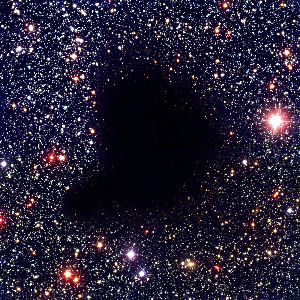 One thing is for sure, Dark Nebula tend to stick out like the proverbial "sore thumb". Case in point, Molecular Cloud Barnard 68 seen at right. "What used to be considered a hole in the sky is now known to astronomers as a dark molecular cloud. Here, a high concentration of dust and molecular gas absorb practically all the visible light emitted from background stars. The eerily dark surroundings help make the interiors of molecular clouds some of the coldest and most isolated places in the universe. One of the most notable of these dark absorption nebulae is a cloud toward the constellation Ophiuchus known as Barnard 68, pictured above. That no stars are visible in the center indicates that Barnard 68 is relatively nearby, with measurements placing it about 500 light-years away and half a light-year across. It is not known exactly how molecular clouds like Barnard 68 form, but it is known that these clouds are themselves likely places for new stars to form. In fact, Barnard 68 itself has recently been found likely to collapse and form a new star system. It is possible to look right through the cloud in infrared light." Credit: FORS Team, 8.2-meter VLT Antu, ESO. Also see the survey
One thing is for sure, Dark Nebula tend to stick out like the proverbial "sore thumb". Case in point, Molecular Cloud Barnard 68 seen at right. "What used to be considered a hole in the sky is now known to astronomers as a dark molecular cloud. Here, a high concentration of dust and molecular gas absorb practically all the visible light emitted from background stars. The eerily dark surroundings help make the interiors of molecular clouds some of the coldest and most isolated places in the universe. One of the most notable of these dark absorption nebulae is a cloud toward the constellation Ophiuchus known as Barnard 68, pictured above. That no stars are visible in the center indicates that Barnard 68 is relatively nearby, with measurements placing it about 500 light-years away and half a light-year across. It is not known exactly how molecular clouds like Barnard 68 form, but it is known that these clouds are themselves likely places for new stars to form. In fact, Barnard 68 itself has recently been found likely to collapse and form a new star system. It is possible to look right through the cloud in infrared light." Credit: FORS Team, 8.2-meter VLT Antu, ESO. Also see the survey 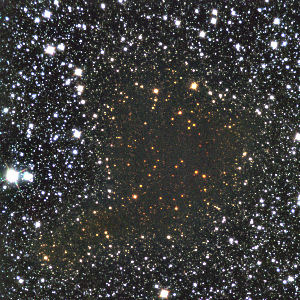 "Some months ago, the ESO Very Large Telescope (VLT) observed a classical dark globule, Barnard 68 (B68) , in front of a dense star field in the Milky Way band. CCD images were obtained in various visual wavebands with the FORS1 multi-mode instrument at the 8.2-m VLT ANTU (UT1).
"Some months ago, the ESO Very Large Telescope (VLT) observed a classical dark globule, Barnard 68 (B68) , in front of a dense star field in the Milky Way band. CCD images were obtained in various visual wavebands with the FORS1 multi-mode instrument at the 8.2-m VLT ANTU (UT1).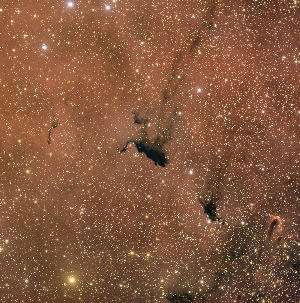 It's a duck! It's a Goose! No, it's the dark nebula
It's a duck! It's a Goose! No, it's the dark nebula 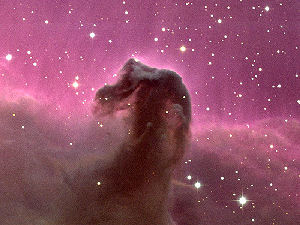 While the name, "LDN 1630" may be somewhat unfamiliar, the object is far from it. It is one of astronomy's most iconic images ever, better known as the "
While the name, "LDN 1630" may be somewhat unfamiliar, the object is far from it. It is one of astronomy's most iconic images ever, better known as the " Zooming back out from the above image, one sees the wide stellar vista wherein resides the Horsehead nebula which is also known as
Zooming back out from the above image, one sees the wide stellar vista wherein resides the Horsehead nebula which is also known as 